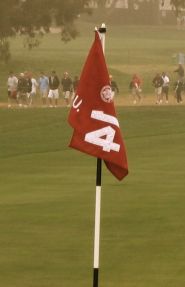"You'll probably will see more of that type of presentation moving forward because we are trying to find more risk/reward..."
/Commissioner Tim Finchem sat down Saturday with the assembled scribes at Sherwood (here, here to Doug Ferguson for suggesting we pull up chairs...it was a long 30 minutes). For a summary of the conversation, you can read Ferguson's focus on the PGA Tour cutting costs and not jobs, while Steve DiMeglio shares some of Finchem's most detailed remarks on the economic crisis's impact. GolfChannel.com posted this short interview with Finchem that also serves as a healthier, more cost effective alternative to your daily Valium consumption.
The Commish talked about the demise of the Hope Classic and I used the opportunity to ask about a rumored shift in over course setup philosophy that we might see in 2009.
Q. You mentioned talking about the Hope, that one of the things that has possibly impacted the tournament was the shift in the way the golf courses played and presented, and now it's going back in the other direction. Do you see that as something that's a shift for that tournament or a shift in general for tour golf courses?
COMMISSIONER FINCHEM: To some extent I would say that it's really two different things, because the Hope, we are talking about a straight configuration of history and culture of the tournament, the atmosphere, what you want to try to accomplish in an environment where you play lots of golf courses during the week, and it's very difficult for a competitor to properly prepare, learning their way around one golf course let alone several.
Having said that, we are looking at ways to have a broader range and variety and set of conditions. We have, you have probably noticed in the last year, we have experimented a fair amount at certain tournaments.
For example, at Boston this year, we set up the 18th hole to where it's very conducive for players to reach the green and be in positions for eagle and birdie, just to see what reaction there was from players and the fans and television viewers.
You'll probably will see more of that type of presentation moving forward because we are trying to find more risk/reward and trying to find more things that create interest for the fans but still maintain the integrity of the competition.
Q. Was that a reaction at all to television ratings or player feedback?
COMMISSIONER FINCHEM: I don't think it's a reaction to television ratings, but it is the recognition that we should be on the weekend making the competition and the play of these golf courses more interesting to fans generally.
Sometimes you miss things and you realize you should be concentrating more -- not that we have necessarily missed anything, but we are putting out more interesting -- those kind of issues as we look at golf courses.
Uh, that's a yes, they are going to try and generate a little more excitement via setup in 2009. That should reassure Peter Kostis, who has expressed concern about some of the oddball setups of 2008 possibly carrying over into next year.
Finchem was also asked to confirm John Marvel's GolfDigest.com report that the Commish is entered in the AT&T Pro-Am at Pebble Beach.
COMMISSIONER FINCHEM: The chairman and CEO of AT&T asked me to play, and I do believe I said, "Yes, sir."
Q. Who is your partner?
COMMISSIONER FINCHEM: Davis Love. It has not been announced yet.
Q. What is your handicap?
COMMISSIONER FINCHEM: I think my index right now is 6.3.
Q. So if you have to play a few tournaments in the schedule, you're trying to lead by example?
COMMISSIONER FINCHEM: I'm going from zero to one.
Q. So who is in your foursome?COMMISSIONER FINCHEM: Hunter Mahan and Randal Stephenson and myself. That's the plan, anyway.














